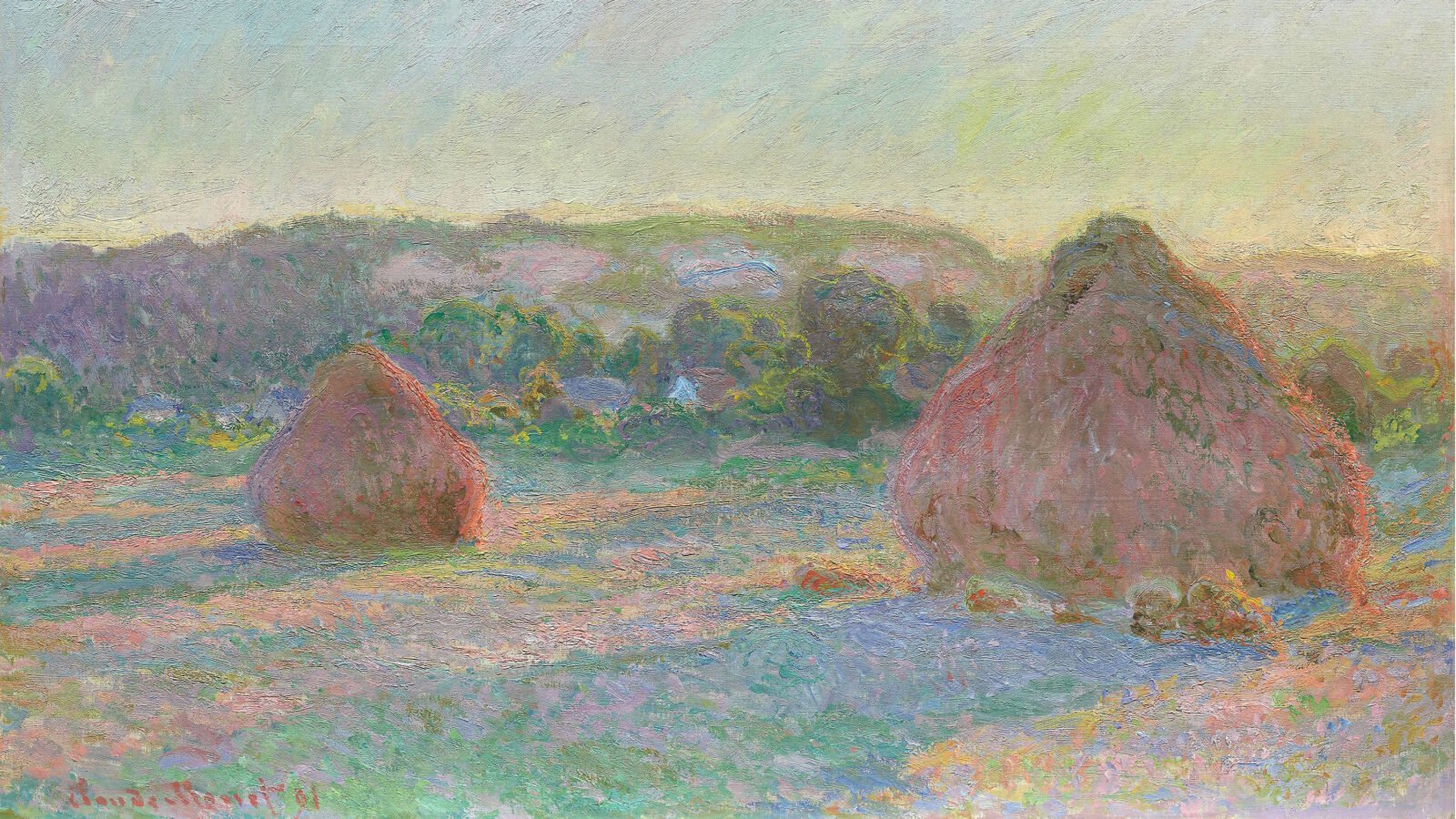
Claude Monet. Stacks of Wheat (End of Summer). 1890/91. The Art Institute of Chicago.
Summer is upon us! Maybe you’ll be spending time with family, soaking up the sun, or just enjoying a quality read. Whatever your plans, we have the perfect musical accompaniment: summery classical music selected by WFMT hosts and staff!
Read about our selections below, or click here to jump to the full playlist.
Quiet City, by Aaron Copland
Many years ago, I heard Copland’s Quiet City at a Grant Park concert. When I say “many years ago,” I mean so far back that the concerts were still at the 11th Street bandshell – before the move to the Petrillo Music Shell, and long before Millennium Park, of course. I had probably heard the piece before, but not so consciously or acutely. It was dusk. I was by myself, sitting on a blanket on the lawn, surrounded by other music lovers. As I listened, I looked out toward the lights of the Chicago skyline and heard the muted sounds of traffic. At that particular moment, there were no wailing sirens or hovering helicopters: just the music, and the quiet evening in a quiet city. — Andi Lamoreaux, music director
El Alevin — Allegro Assai, by Eduardo Angulo
The sounds of summer and nature are abundant in this melodic and technical piece by Mexican composer Eduardo Angulo. El Alevin translates to “the minnow” and is the musical journey of a little fish through a river and all the beauty and danger along the way. A perfect accompaniment to hikes in the woods, tubing downstream, or a picnic by the lake. This version was recorded as part of a Fiesta program and released on the Chicago record label Delmark as a collaboration with WFMT. Enjoy! — Dan Goldberg, radio producer
"Bailero" from Chants d'Auvergne, by Joseph Canteloube
This simple but haunting song takes me to a warm, sun-filled landscape every time I hear it. Joseph Canteloube based the song on a folk melody from Auvergne in central France. It opens with a plaintive oboe solo, evoking the hills and fields of the region. A young woman, singing in the local dialect, calls out to a shepherd. She invites him to bring his flock to her meadow where the grass is greener. — Lisa Flynn, program host
"Prologue" from Symphony No. 2: The Age of Anxiety, by Leonard Bernstein
Leonard Bernstein said he was “breathless” while reading The Age of Anxiety, W.H. Auden’s Pulitzer prize-winning poem, calling it "one of the most shattering examples of pure virtuosity in the history of English poetry." Neither the poem nor the work has anything in particular to do with summer, but another poem by Auden does: A Summer Night. If one were to read while listening to music — I certainly do — I’d recommend this poem to accompany the first movement of Bernstein’s Age of Anxiety. Written in 1933, Auden speaks of lush “windless nights of June” and “sexy airs of summer, [t]he bathing hours and the bare arms,” providing a counterpoint to the solitary musical lines in Bernstein’s work; the voices that come and go, reach an accord, and go their separate ways; still, somehow, connected, as we all are. — Candice Agree, program host and radio producer
The Cunning Little Vixen Suite: I. Modra vazka (The Blue Dragonfly), by Leoš Janáček
I’ve done a lot of different jobs in the creative world, but the only time I’ve operated lights was for a chamber production of The Cunning Little Vixen. One hot New Zealand summer, our opera company covered nearly the entire length of the North Island with two vans and two trailers. Leoš Janáček’s opera cycles through the seasons, starting with a languid, sticky summer afternoon in the forest. In the opening scene, dragonflies flit around a badger, the Forester dozes off in the heat, and Vixen Sharp-Ears scares a frog right onto the Forester’s nose. — Robbie Ellis, announcer
Le cygne from Le carnaval des animaux, by Camille Saint-Saëns
The image of a gentle swan graceful gliding past a lily pad evokes the splendor of summer encountered while strolling in a garden or perhaps a beautiful municipal park. The Swan, or Le cygne, is the penultimate movement of the fourteen-part work Carnival of the Animals by Camille Saint-Saëns. Composed in 1886, the suite was originally written for fun, and Saint-Saëns forbade it from being publicly performed during his lifetime. The one exception was an arrangement of The Swan, which he had originally scored for cello and two pianos. The fluid cello line embodies the swan floating upon the rippling water of the piano accompaniment. — Mary Mazurek, audio engineer
String Quartet No. 4, II. Prestissimo, by Béla Bartók
On a summer’s walk in Down East Maine, I found myself thinking about the life cycle of a mosquito and recalling the second movement of Béla Bartók’s String Quartet No. 4. To quartet players, this Prestissimo con sordino (as fast as possible with muted strings) tells a story of swarming mosquitos that bite. The final chord is about arriving home and slamming the front door. — Cydne Gillard, radio producer
"El balón" from Ma ma, by Alberto Iglesias
The end of summer is a time that I always find to be bittersweet. During its “impervious finale” — the period when the days get shorter and August turns to September — I sit on my porch at dusk, reflecting on my summer and feeling some angst about the colder seasons to come. This quiet, cloudy piece by Alberto Iglesias, which was written for the Spanish film Ma ma, seems to capture the feelings of these idle moments, which are charged with bliss, wistfulness, and disquiet, sometimes all at once. — Keegan Morris, multimedia producer
Knoxville: Summer of 1915, by Samuel Barber
The mood of Samuel Barber’s Knoxville: Summer of 1915 of my childhood in a small, quiet Appalachian town, of the people who were so dear to me, and of the soft sentimentality of a summer evening. I love this recording by Leontyne Price because, even though she sings the piece with her big, soaring Verdi soprano voice, she manages to convince me that she is the little boy who is the protagonist of the piece. I don’t know how she does it, other than by magic. — George Preston, general manager
"Das Glühwürmchen" from Lysistrata, by Paul Lincke
As the evening falls, fireflies, crickets, and glow-worms set the stage for a warm summer night. “Das Glühwürmchen,” or “The Glow-Worm,” was written by Paul Lincke in 1902 for his German operetta Lysistrata. While the piece is also popular as a standalone orchestral instrumental, the original German text had been translated into English and was popularized by a few American recording artists, including the Mills Brothers. I don’t particularly enjoy any sort of creepy-crawlies (huge NOPE on spiders) but I would guess that a lot of us have fun childhood memories catching and releasing lightning bugs, so the cute and shimmery Glühwürmchen is okay in my book. — Becky Nystedt, production coordinator
"Out to Sea / The Shark Cage Fugue" from Jaws, by John Williams
My summer pick comes from the film score works of American composer-conductor John Williams. Anyone who says that film music is not a legitimate category worthy of our attention needs to get a bigger boat! One of the hallmarks of a Williams score is the brilliant use of theme and counterpoint, used to exhilarating and chilling effect in this piece from the film score of the 1975 summer blockbuster Jaws. From its sweeping introductory bars, to the joyful sea-faring piratical theme, and the creeping in under the surface of more cold-blooded menacing elements, nearly the entire story is told in less than 5 minutes. The release of this film at the beginning of the summer beach season in 1975 may not have had a booming effect on the Vacation Destination industry, but it was a big splash ( thanks ladies and germs; I’ll be here all week) for cinematic music lovers! — Maggie Clennon Reberg, program host
Siboney, by Ernesto Lecuona
The exemplary pianist Rubén González, a former member of the Buena Vista Social Club, defined Son, one of the characteristic genres of Cuban music. González’s rendition of the classic Ernesto Lecuona piece Siboney will always remind me of warm summer nights with my family. Savory food; ice-cold drinks; the lingering scent of cigar smoke. A cafecito – why not? This is no-worries music that will be the perfect toast for your summer gathering. ¡Salud! — Michael San Gabino, radio producer






